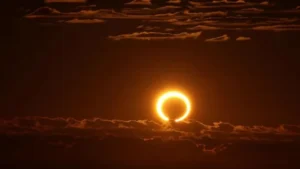“October 14, 2023 Solar Eclipse: Safety Tips and Viewing Guide for North, Central, and South America”
A partial solar eclipse will cross North, Central, and South America on October 14, 2023. It will be visible in a number of Central and South American nations as well as areas of the United States, Mexico, and Europe.
Millions across the Western Hemisphere will have the opportunity to witness this celestial event.
Never gaze at the Sun directly during a solar eclipse without protective eyewear. Review the safety instructions before getting ready on October 14, 2023.
Two significant solar eclipses will shortly occur in North America when the Sun, Moon, and Earth line up perfectly. On October 14, 2023, a “crescent” eclipse will be visible to observers along a line running from Oregon to Texas and then through parts of Central and South America. Eight months later, on April 8, 2024, a complete solar eclipse spanning from Mexico to Eastern Canada will turn day into night and let lucky watchers under clear skies see the magnificent solar corona. Weather allowing, almost everyone in North America will witness at least a partial solar eclipse.
Do you recall the August 21, 2017, total solar eclipse that spanned the entire country from coast to coast? The moment the Moon totally obscured the Sun’s dazzling face for a few minutes whether you were living near or going to the route, which was roughly 70 miles wide, is an experience you won’t soon forget. You might have seen a partial solar eclipse on that day if you were anywhere in North America (or Northern South America) and were outside beneath the open sky.
The 2017 total solar eclipse was the first to cross the United States from coast to coast since 1918 and the first to impact the “Lower 48” since 1979. Surprisingly, North America will experience another total solar eclipse on April 8, 2024, at a little after 7 o’clock. The main difference this time is that the Moon’s deep center shadow, which is nearly 115 miles wide, will pass over Mexico before darkening eastern Canada and casting a broad shadow from Texas to Maine. If the weather cooperates, practically everyone in North America will experience a partial solar eclipse.
Even more notable is the fact that North America will experience a different kind of solar eclipse just six months earlier. On October 14, 2023, the Moon will once again pass directly in front of the Sun, but this time it won’t fully obscure it; it will only appear as a thin “ring.” An over 125-mile wide path from Oregon to Texas and from Mexico to Northern South America will be covered by this annular (ring-shaped) eclipse. If the weather is kind, practically everyone in North America will be able to see partial solar eclipses once more outside the path.
More about Solar Eclipse
The Moon only partially blocks the Sun’s brilliant face during a partial solar eclipse (left). The Moon passes in front of the Sun directly during an annular eclipse (center), although it appears to be in a very thin ring, with the “ring of fire” still visible. The sky seems gloomy in the first two photos because they were taken through a safe solar filter that only let through 1/100,000th of the Sun’s light. equally the fully eclipsed Sun is equally safe to gaze at as the full Moon and so spectacular, we were without a sun screen during the total solar eclipse. Rick Fienberg, Sky & Telescope, and TravelQuest International are the sources for all images.
First, Safety Precautions: When the Sun is completely blocked by the Moon during the total phases of a solar eclipse, it is safe to look at the Sun without special eye protection for a split second. The Sun’s corona, its ethereal, wispy outer atmosphere, can be seen as the sky grows darker. The total eclipse on April 8, 2024, will endure for a maximum of over 412 minutes and will only be visible along a short route that emerges from the shadow of the Moon. However, even inside that route, the Sun will be partially obscured for more than an hour prior to and during the complete phase. You should always wear eye protection when gazing toward the Sun during those partial phases!
When viewing the Sun during the October 14, 2023 lunar eclipse, it is crucial to use a solar filter that complies with international standards like ISO 12312-2 because a portion of the Sun’s bright face will be visible throughout the entire event. This kind of filter is widely accessible and just costs a few bucks. When a solar eclipse is fully visible, whether total or annular, looking at it with uncovered eyes or via an unapproved filter can seriously harm your eyes and even cause lifelong damage.
Never look at the Sun during an eclipse without appropriate eye protection, and always abide by safety precautions to preserve your vision.


